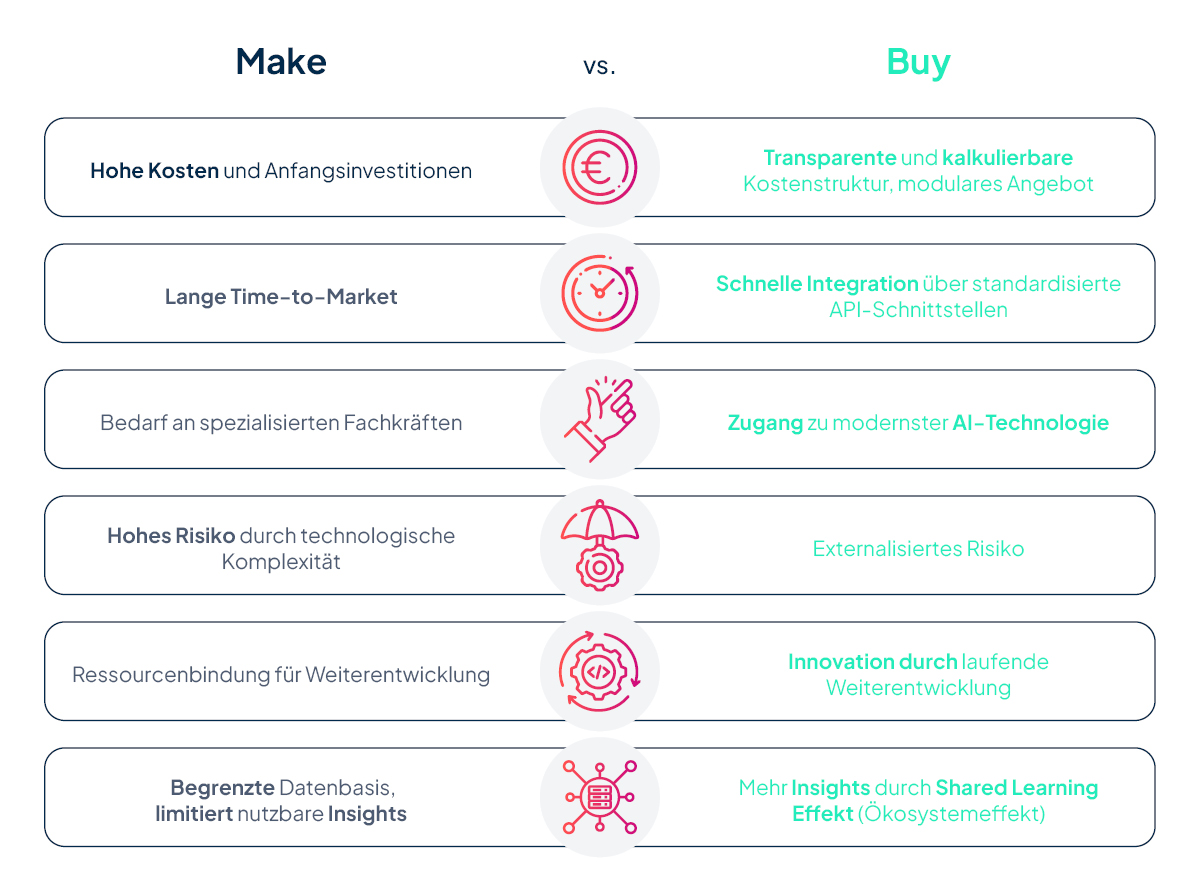Develop it in-house or purchase it?
The fastest way for banks to leverage the potential of transaction data
The fastest way for banks to leverage the potential of transaction data

Partnering with External Specialists: The Smart Way to Develop Customer-Centric Solutions
Personalised offers and value-added services delivered precisely when they are relevant to everyday life – that’s what today’s banking customers expect from their financial institutions.
This is now possible thanks to AI-powered transaction data analysis. Evaluating account activity provides the insights needed for truly individualised customer experiences. Yet only a few financial institutions have the necessary technological capabilities in-house to achieve this.
Against this backdrop, banks urgently need to determine how to develop customer-centric offerings as efficiently and quickly as possible. Should they build the necessary AI capabilities for transaction data analysis in-house, or would it be better to purchase external solutions?
In the following, we take a closer look at the all-important “build or buy” question. We also explain why the smart answer for many financial institutions is not either-or, but rather a partnership. By taking this deliberate strategic approach, banks can benefit from external partners in a quick, agile, and flexible manner.
The Pros and Cons of In-House Development
At first glance, developing in-house digital capabilities for transaction data analysis offers numerous advantages. The institution remains independent of third-party providers and can prioritise the fulfillment of its specific requirements. However, there are significant disadvantages to bear in mind:
- Lack of resources and talent: Specialists with the necessary skills for developing and maintaining systems are in short supply, and banks often lack sufficient IT resources.
- Time to market: Software development and training AI models require a significant amount of time and numerous iterations. Rolling out new offerings gets delayed, and internal expectations, such as those from the board of directors, cannot be met quickly enough.
- High costs: The total cost of ownership (TCO) for an in-house development is substantial, due to high initial investments as well as ongoing expenses for further model development and maintenance.
- Technological complexity: Developing AI applications in-house places high technical demands on the company and carries risks. Mistakes can be extremely costly.
- Innovation backlog: Launching the solution is just the beginning – banks must continuously develop and improve their applications.
- Long-tail effect: Fully enriching transaction data is extremely challenging due to the long-tail effect. In other words, the first 70% of transactions are relatively easy to categorise. However, the effort required increases exponentially for the remaining transactions, as significantly more data is needed for accurate matching. This area, which is difficult to categorise, often includes one-off but particularly important expenses (read more about the long-tail effect here).
The Smarter Approach: Buy, But With the Right Partner
The disadvantages and risks listed above show that a complete in-house development is only worthwhile if the financial institution already has established teams and the appropriate technology platforms in place.
If these prerequisites aren’t met, collaboration with FinTechs like Contovista is a viable option. They solve the technological and business challenges of in-house development with ready-to-use SaaS applications for API- and AI-based transaction data analysis.

Figure: Advantages and disadvantages of independent development vs. external purchase
With Contovista, “Buy” Becomes the Smart Decision
Given these benefits, buy is likely to be the much smarter choice for many established financial institutions.
With Contovista, buy becomes the smart decision, enabling banks to actively shape the solution while meeting specific Swiss regulatory requirements.
- Active involvement: Banks can provide input on the solution and development roadmap within the Contovista community, e.g. through the Product Board.
- Short time-to-market: Using ready-to-deploy applications reduces the time needed to develop and roll out customer-centric offerings.
- Precise categorisation approach: Contovista delivers transaction data analysis with outstanding accuracy of 98% thanks to state-of-the-art algorithms. The solution is continuously being improved, with new releases every six months. This ensures that the latest market trends, such as hyper-personalisation and smart AI applications, are future-proofed.
- Shared learning effect: Contovista’s approach delivers better results for banks thanks to shared insights. Partner banks send non-personal data (non-CID data) to our data centre. This much larger database allows the algorithms to be further refined, which benefits all institutions.
- Optimal compliance: Swiss data protection and compliance requirements are met, with operations taking place in a Swiss data centre.
- Tailor-made options: Our solution enables attractive services that are precisely tailored to end customers in Switzerland and their specific needs, e.g. in the areas of taxation or pension provision.
- Integration into the ecosystem: Contovista collaborates with other technology providers, facilitating the integration of new capabilities (e.g. CRM, ERP, workbenches).
- Experienced partner: Contovista has been on the market for over twelve years and is the market leader in Switzerland.
- Made in Switzerland: Contovista’s solutions are developed in Switzerland, ensuring exceptional quality, security, and reliability. Local development and support guarantee compliance with strict data protection and privacy regulations.
«Modular architecture is crucial for banks, as it allows them to integrate technological innovation into their existing systems gradually and in a controlled manner – without the need for extensive restructuring. This is one of the key benefits of Contovista’s solution: it can be deployed as a ready-to-use all-in-one package or configured by the financial institution according to individual needs and expanded gradually over time»
Faheem Ullah, Head of Technology, Contovista
Build or Buy?
The Answer is Collaboration!
The takeaway for ambitious banks looking to accelerate their digital transformation: those who take their data strategy seriously shouldn’t think in rigid either-or terms, but in terms of ecosystems. Banks don’t have to develop everything themselves – but they should buy strategically and focus on close collaboration with their technology providers.
Contovista’s solution offers maximum functionality with minimum effort:
- Speed: Easy integration, fast results
- Scalability: Performance reserves and modular expansion, including in the SaaS model
- Future-proof: Continuous development and new AI features
Contovista opens up entirely new possibilities through forward-looking finance management and analytics solutions, especially when it comes to customer centricity.